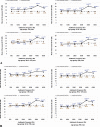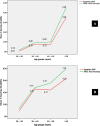Prevalence and correlates of occupational noise-induced hearing loss among workers in the steel industry
- PMID: 37271796
- PMCID: PMC10239744
- DOI: 10.1186/s42506-023-00135-7
Prevalence and correlates of occupational noise-induced hearing loss among workers in the steel industry
Abstract
Background: The steel industry is one of the noisiest industries, which can predispose workers to hearing loss. In Egypt, the demand for steel is increasing due to the construction of new infrastructures as bridges, flyover roads, buildings, and towers; however, little is known about the prevalence of occupational noise-induced hearing loss (NIHL) among steel workers. Understanding the distribution of the affected workers is crucial for planning prevention strategies. This study aimed to estimate the prevalence of occupational NIHL among Egyptian steel workers and identify its correlates.
Methods: This study was conducted at two steel factories in Egypt in November 2021. It involved an initial retrospective review of the factory medical records of the latest periodic medical examination conducted on workers from July to September in the year 2021 representing workers' health status in that year. Then, a case-control approach analysis was carried out. Eligible workers (n = 606) were enrolled and divided into two groups: noise-exposed workers (n = 396) and unexposed workers (n = 210). Univariate and multivariate regression analyses were performed.
Results: Occupational exposure to hazardous A-weighted equivalent noise level (> 85 dB) was associated with higher hearing thresholds at all frequencies (highest at 4 kHz followed by 6 kHz), particularly in younger workers below the age of 40 years. Nearly 71% of noise-exposed workers had hearing impairment, and 47% had NIHL compared with unexposed workers (45.7% and 11.9%, respectively). The probability of NIHL in noise-exposed workers was 6.55 times higher than that in unexposed workers (OR = 6.55, 95%CI = 4.13, 10.40; p < 0.001). In noise-exposed workers, age and tinnitus were independent predictors of hearing thresholds, while tinnitus was found to be an independent predictor of NIHL after adjusting for age and job duration (OR = 2.06, 95%CI = 1.01, 4.20; p = 0.045).
Conclusion: Almost half of noise-exposed workers had NIHL. Tinnitus was found to be an independent predictor of NIHL. Decreasing noise exposure levels in steel plants is recommended to reduce hearing loss. Future research is required to study the effect of tinnitus on audiometry measurements among workers with NIHL.
Keywords: Hearing impairment; Noise-induced hearing loss; Tinnitus.
© 2023. The Author(s).
Conflict of interest statement
The authors declare that they have no competing interests.
Figures


References
-
- World Steel Association. World Steel in Figures 2015. Available from: https://www.worldsteel.org/media-centre/press-releases/2015/world-Steel-.... Accessed 13 Jan 2022.
-
- Ramakgala C, Danha G. A review of iron making by direct reduction processes: quality requirements and sustainability. Proc Manufact. 2019;35:242–245. doi: 10.1016/j.promfg.2019.05.034. - DOI
-
- Parameswarappa SB, Narayana J. Impact of noise on hearing and hypertension among workers in steel industry. Int J Curr Microbiol App Sci. 2015;4(1):124–33.
LinkOut - more resources
Full Text Sources
Miscellaneous

